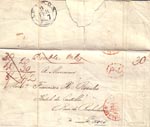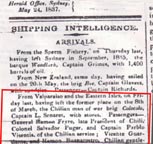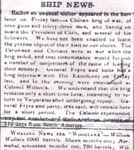Eunice and Ron Shanahan have shared with readers of the Victorian Web this material from their website, Letters from the Past. Click on thumbnails for larger images.
This letter is written in Spanish. It was sent from London to Paris, and has links with Chile in South America and finally Sydney in Australia.
Postal Markings

The postal markings are of interest. It has been annotated as being Double only, which has then been crossed out and the sums written are in pence on the left 30 plus 30 equalling 5/- (60 pence = 5 shillings) that has been crossed out as well and 20 plus 30 substituted equalling 50 pence, which was four shillings and two pence. This was all in red ink as it was a pre-paid letter, and there is also a 30 on the far right of the envelope, which is part of the cost. The P..D in a circle shows that the postage has been ‘Paid to Destination’ so that the addressee would not have to pay anything on receipt of the letter. The catalogue shows that this was in use from 1839-1856, but this letter is clearly dated 1837.
The LONDON date stamp 9 FEB 1837 was applied in black on the back of the letter. This type of postmark was introduced in 1836 and was the first date stamp which actually contained the name of LONDON.
On the front, a transit stamp has been applied but only partially struck. It is Calais and the date only shows FEVE (for February) with the year 1837 inverted. There is no stamp to show the arrival date in Paris.
The Letter
The letter, which is addressed to “Monsr. Francisco X. Rosales, Hotel de Castille Rue de Richelieu a Paris,” begins with business matters:
Señor Don Francisco Xavier Rosales
London February 9th, 1837
We are pleased to see from your letter of the 6th of this month, of your safe arrival, but suspect that given the bad time of the year, your journey would not have been very enjoyable.
We are very pleased that you received the several bills that we remitted to you, before you left, but regret the omission of the account of the purchase and sale of the Exchequer Bills, and trust that this will not have caused you any inconvenience..
We have lost no time in sending you the enclosed copies of both bills, the Purchase one dated November 15 1822 and the Sale one with revenue and premium dated August 6th 1824 totalling £10765.18.3, which amount was paid into the Emprestito account Number 1. We trust that you will now find all copies of the bills to be in order .
Note: Exchequer Bills are issued by the Treasury Department of the Government, as a loan on a fixed term of interest. They always used to be a low rate of interest, but were guaranteed to be safe. It is one of the ways in which a Government can legally raise money. This seems a large amount of money for that time, but I was unable to discover with what business they were involved. The letter continues with international news.
As we have seen in a few letters and newspapers of the last days of September, that since the arrival of the Stentor at Hastings, it looks as though the career of Mr. Ramon Freire is finished in Chile, showing the weakness of his party and the strength of the government.
They confirm the news of the expedition of Chilean ships sent against Callao and add that General Blanco having taken over the command of the Chilean fleet has increased it with the purchase of a French ship at a cost of $40000, and with the addition of 2 Peruvian ships involved in the expedition of Senor Freire.
All the circumstances point to the belief that Mr. Egana has made a very favorable agreement, having taking advantage of the favorable position which Chile has attained, and will secure a permanent peace.
We are honoured to repeat that we are at your disposal
your most humble and obedient servant
Hullett Hermanos y Ca.
The reference to the Stentor at Hastings is interesting, as ships carrying mail for London which sailed through the English Channel could offload the mail at Hastings, which is a town on the south coast of England, where it was picked up by rowing boat, and then delivered to London by mailcoach. This was often quicker than continuing to sail up the Channel and then up the Thames Estuary to London – especially if the weather was poor, as it could have been at that time of the year.
The link with Sydney Australia concerns Senor Ramon Freire. According to Simon Collier and William F. Sater, (p. 65) “In July 1836 the exiled Gen. Freire led a small expedition to Chile from Peru in an attempt to overthrow the Conservative regime. Freire was captured, put on trial, and banished to Australia.” This seemed odd to me, so I contacted Simon Collier and asked him if this was right, and he replied
It may seem far-fetched to think of a Chilean politician exiled to Australia in the 1830s, but yes, it did happen. General Ramon Freire, after his abortive rising, was sent there aboard a Chilean warship, the Colocolo , and was dumped in Sydney – sometime early in 1837. Of course there was no way the Chilean government could keep him there, and I imagine that the colonial authorities could not have cared less. He did not stay very long in Sydney, and eventually drifted across to Tahiti, where he befriended Queen Pomare, and lived for some years, later moving to Bolivia. The Chileans let him come home in the early 1840s, after the amnesty of 1841, and he died in Santiago in 1851. In the 1830s and 1840s there were quite a few ships that travelled between Chile and Australia - mostly British ships carrying cargoes of wheat, for which there was often a demand in NSW and Victoria, given the early emphasis on sheep and wool in those colonies. Later on, in the 1850s, there was a very big trade in wheat during the gold rush, though it lasted only a few years. So there was actually more in the way of contact than you might suppose.
Another of my contacts, this time from the University of Queensland, advised me that there was a trade in silver from Peru to India, and many of the ships in this trade stopped in Australia — or even took side trips to Australia from South America, if there was insufficient silver to load when they arrived. If I could find the date he left South America, or, ideally, the name of the ship he left on - it should be possible to see if that ship wound up in Australia at a later date.

So my next move was to check the shipping movements in 1837 and sure enough, the Sydney Morning Herald Newspaper printed the shipping Intelligence, and I was able to get a photocopy from their microfiche. However, the quality is rather poor, so I have quoted the details here
Herald Office, Sydney May 24 1837
Shipping Intelligence
Arrivals
From Valparaiso and the Eastern Isles, on Friday last, having left
the former place on the 8th of March, the Chilian man of war brig Colocolo,
Captain L. Senaret, with stores. Passengers : General Ramon Fryre, late President
of Chili; Colonel Salvador Pugar, and Captain Parblo Visentis of the Chilian
service; Vicente Guardante, and Ramon Buanarostro, Chilian gentlemen.
Then on the next page in the Ship News there is this surprising paragraph

“Rather an unusual visitor appeared in the harbour on Friday last — a Chilian brig of war, of nine guns and thirty-three men, and having on board the President of Chili, and several of his followers. We have not been enabled to learn the precise object of their visit to our shores. The Peruvians and Chilians were at war when the brig sailed, and that circumstance would furnish a number of conjectures of the cause of leaving their country. General Fryre and suite had a long interview with His Excellency on Friday last, and in the evening were entertained at Colonel Wilson’s. We understand that the brig remains only a short time here, intending to return to Valparaiso after undergoing repair. General Fryre and party, it is said, will remain here for a short period. The Colocolo experienced very bad weather and made a tortuous passage of 112 days from South America.”
However, the idea of permanent peace mentioned in my letter, did not come about, as history shows that the chief development in Chilean foreign relations during this period of Conservative dominance was a series of conflicts with neighbouring countries, first with Bolivia and Peru in 1836, and then with Argentina, beginning in 1843.
Last modified 28 May 2010